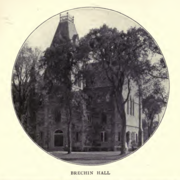- Academy Hall, Phillips Academy, Andover, Massachusetts, 1865.
- Brechin Hall, Andover Theological Seminary, Andover, Massachusetts, 1866.
- Sears Building, Boston, Massachusetts, 1868-69.
- Capen School, South Boston, Boston, Massachusetts, 1870-71.
- Mason & Hamlin Store, Boston, Massachusetts, 1870.
- Hotel Boylston, Boston, Massachusetts, 1871.
- House for Charles Amos Cummings, Boston, Massachusetts, 1872.
- Congregational House, Boston, Massachusetts, 1873.
- First Universalist Church, Lynn, Massachusetts, 1873.
- Old South Church, Boston, Massachusetts, 1873-75.
- Interior of the Old South Church, Boston, Massachusetts, 1873-75.
- Bedford Block, Boston, Massachusetts, 1874-75.
- Macullar, Parker & Company Store, Boston, Massachusetts, 1874.
- Montgomery Building, Boston, Massachusetts, 1874.
- Yale University Boathouse, New Haven, Connecticut, 1874-75.
- Stone Chapel, Andover Theological Seminary, Andover, Massachusetts, 1875-76.
- Tyn-Y-Coed Hotel Campobello Island, New Brunswick, Canada, 1882.
- Magnolia Library, Magnolia, Massachusetts, 1887.
| Cummings & Sears | |
|---|---|
| Practice information | |
| Founders | Charles Amos Cummings, Willard T. Sears |
| Founded | 1864 |
| Dissolved | 1889 |
| Location | Boston, Massachusetts |

Cummings and Sears (est. 1864) was an architecture firm in 19th-century Boston, Massachusetts, established by Charles Amos Cummings and Willard T. Sears. [1]


















